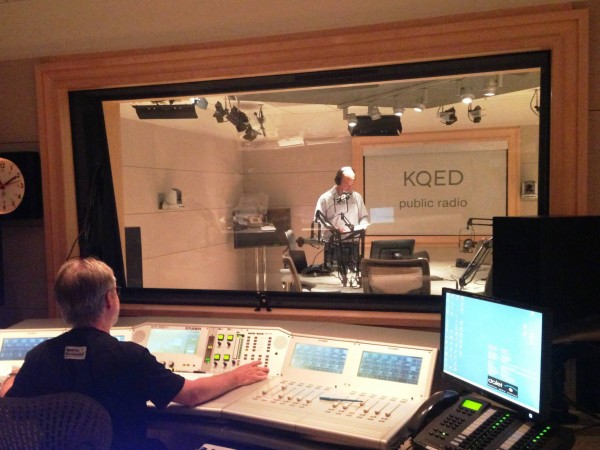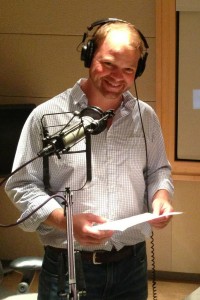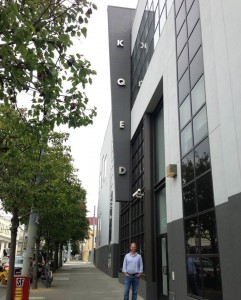22 October 2013
On the air with a paleoclimatologist
Posted by mcadams

Mike Osborne, AGU’s 2013 Mass Media Fellow, records a story in the KQED studio. Photo by Dione Rossiter.
By Mike Osborne
The path of science news goes something like this: Nature is doing something interesting, scientist discovers the interesting thing, reporter talks to scientist, public hears reporter, public understands nature better, world is a better place. This is what I learned over the summer working as a science reporter at KQED public radio in San Francisco.
This summer, AGU sponsored me as an American Association for the Advancement of Science (AAAS) Mass Media Fellow. The fellowship gives about a dozen young scientists each year the opportunity to cultivate their communications skills while also providing media outlets with a temporary scientific expert.
For 10 weeks, I took a break from paleoclimatology and isotope geochemistry to work as a science reporter. When I learned that I’d be working at KQED, I was through the roof with excitement. KQED has a robust science newsroom—a rarity in today’s media landscape—and reaches about 750,000 listeners a week, according to their website.

Osborne, seen here in the KQED studio, is a Stanford University PhD student of paleoclimatology. Photo by Dione Rossiter.
To give you a sense of what the fellowship was like, here’s a description of my typical day: I’d arrive at my cubicle and read story ideas—the science press releases from universities and other institutions—that filled my email inbox. I’d pitch some of the more interesting scientific studies to my producers and would exchange a flurry of emails about which stories should appear on the evening broadcast. After isolating a couple topics, an editor would make the final decision, and I’d have an assignment.
As soon as an editor assigned a story to me, I would schedule a phone interview for that day with the study’s main author. Then I would get to work reading the science report, asking myself, “What is the one sentence that summarizes the newsworthiness of this scientific finding?” As I learned from my managing editor, answering this simple yet crucial question is central to the art of quality science reporting.
During the phone interview in the early afternoon, I would listen carefully for a quote summarizing the story. Next I’d write a script, stitch in the quote, and send it to my editor, working with him or her on any needed revisions (writing is collaborative, and revisions were always needed). Once the script was approved, I would go into the studio to record. As soon as I voiced the story, the sound engineers would prepare the story in time for the evening’s broadcast.
So went about every day for 10 weeks. Most of my stories had little relation to my scientific research. I did stories on the physics of sailing, a threatened owl species, how mammals can choose their offspring’s gender, and many more topics. My favorite story of the summer was a piece I did on northern California’s Shasta Dam because it required me to research the fascinating and ongoing history of California’s battles over water.
Start to finish, it was a blast. I got a huge rush every time I said, “For KQED News, I’m Mike Osborne.” I would say that final line with as much gravitas and self-importance as I could muster. I wanted to sound like a pro, even if the gig was temporary.
The most important thing I learned as a science reporter is that you have to always think from the perspective of the audience. What do they need to know? Now that the summer is over and I’ve returned to my research, I’ve been thinking, “As scientists, who is our audience, and what do they need to know? What story are we trying to tell?”
The answer is probably different for all of us, but I think it’s important. After all, the science story begins with us.
For AGU, I’m Mike Osborne.
— Mike Osborne is AGU’s 2013 Mass Media Science and Engineering Fellow. He spent his 10-week fellowship at KQED in San Francisco, Calif. Osborne, who is a co-creator and producer of the Generation Anthropocene podcast, is a Stanford University Ph.D. student of paleoclimatology. Click here to read his blog from the KQED newsroom.
This story also appeared in the 22 Oct. 2013 issue of Eos.



 The Plainspoken Scientist is the science communication blog of AGU’s Sharing Science program. With this blog, we wish to showcase creative and effective science communication via multiple mediums and modes.
The Plainspoken Scientist is the science communication blog of AGU’s Sharing Science program. With this blog, we wish to showcase creative and effective science communication via multiple mediums and modes.